The Bulldozer Review: AMD FX-8150 Tested
by Anand Lal Shimpi on October 12, 2011 1:27 AM ESTPower Management and Real Turbo Core
Like Llano, Bulldozer incorporates significant clock and power gating throughout its design. Power gating allows individual idle cores to be almost completely powered down, opening up headroom for active cores to be throttled up above and beyond their base operating frequency. Intel's calls this dynamic clock speed adjustment Turbo Boost, while AMD refers to it as Turbo Core.
The Phenom II X6 featured a rudimentary version of Turbo Core without any power gating. As a result, Turbo Core was hardly active in those processors and when it was on, it didn't stay active for very long at all.
Bulldozer's Turbo Core is far more robust. While it still uses Llano's digital estimation method of determining power consumption (e.g. the CPU knows ALU operation x consumes y-watts of power), the results should be far more tangible than what we've seen from any high-end AMD processor in the past.
Turbo Core's granularity hasn't changed with the move to Bulldozer however. If half (or fewer) of the processor cores are active, max turbo is allowed. If any more cores are active, a lower turbo frequency can be selected. Those are the only two frequencies available above the base frequency.
AMD doesn't currently have a Turbo Core monitoring utility so we turned to Core Temp to record CPU frequency while running various workloads to measure the impact of Turbo Core on Bulldozer compared to Phenom II X6 and Sandy Bridge.
First let's pick a heavily threaded workload: our x264 HD benchmark. Each run of our x264 test is composed of two passes: a lightly threaded first pass that analyzes the video, and a heavily threaded second pass that performs the actual encode. Our test runs four times before outputting a result. I measured the frequency of Core 0 over the duration of the test.
Let's start with the Phenom II X6 1100T. By default the 1100T should run at 3.3GHz, but with half or fewer cores enabled it can turbo up to 3.7GHz. If Turbo Core is able to work, I'd expect to see some jumps up to 3.7GHz during the lightly threaded passes of our x264 test:
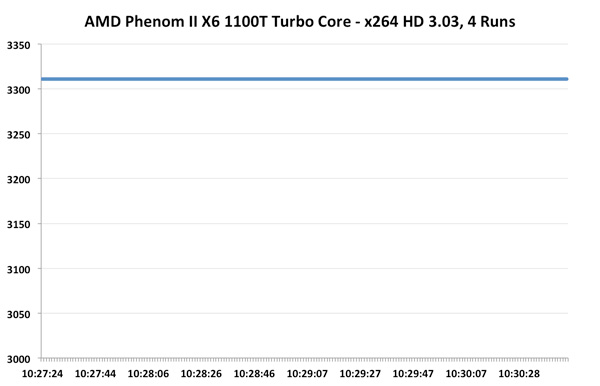
Unfortunately we see nothing of the sort. Turbo Core is pretty much non-functional on the Phenom II X6, at least running this workload. Average clock speed is a meager 3.31GHz, just barely above stock and likely only due to ASUS being aggressive with its clocking.
Now let's look at the FX-8150 with Turbo Core. The base clock here is 3.6GHz, max turbo is 4.2GHz and the intermediate turbo is 3.9GHz:
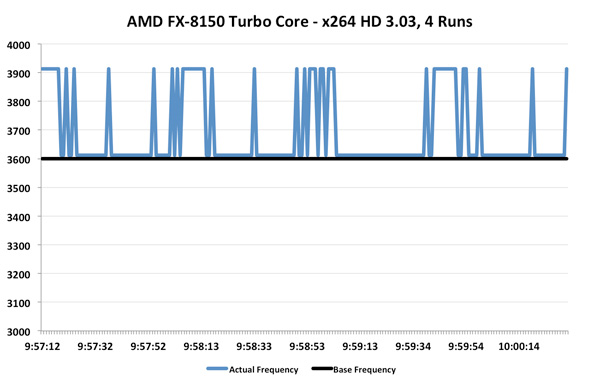
Ah that's more like it. While the average is only 3.69GHz (+2.5% over stock), we're actually seeing some movement here. This workload in particular is hard on any processor as you'll see from Intel's 2500K below:
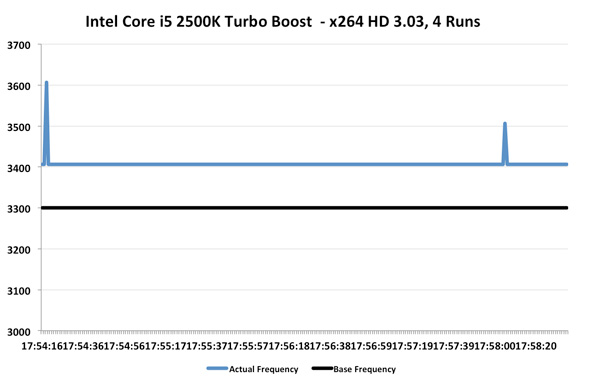
The 2500K runs at 3.3GHz by default, but thanks to turbo it averages 3.41GHz for the duration of this test. We even see a couple of jumps to 3.5 and 3.6GHz. Intel's turbo is a bit more consistent than AMD's, but average clock increase is quite similar at 3%.
Now let's look at the best case scenario for turbo: a heavy single threaded application. A single demanding application, even for a brief period of time, is really where these turbo modes can truly shine. Turbo helps launch applications quicker, make windows appear faster and make an easy time of churning through bursty workloads.
We turn to our usual favorite Cinebench 11.5, as it has an excellent single-threaded benchmark built in. Once again we start with the Phenom II X6 1100T:
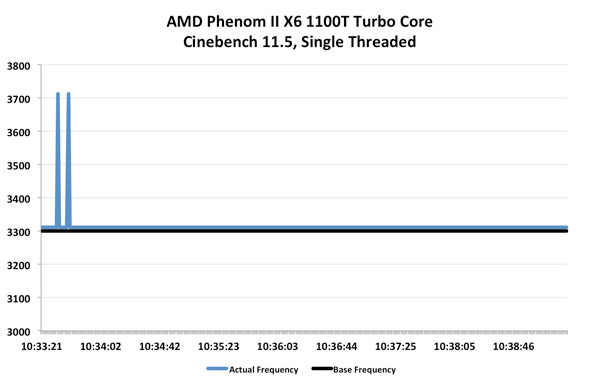
Turbo Core actually works on the Phenom II X6, albeit for a very short duration. We see a couple of blips up to 3.7GHz but the rest of the time the chip remains at 3.3GHz. Average clock speed is once again, 3.31GHz.
Bulldozer does far better:

Here we see blips up to 4.2GHz and pretty consistent performance at 3.9GHz, exactly what you'd expect. Average clock speed is 3.93GHz, a full 9% above the 3.6GHz base clock of the FX-8150.

Intel's turbo fluctuates much more frequently here, moving between 3.4GHz and 3.6GHz as it runs into TDP limits. The average clock speed remains at 3.5GHz, or a 6% increase over the base. For the first time ever, AMD actually does a better job at scaling frequency via turbo than Intel. While I would like to see more granular turbo options, it's clear that Turbo Core is a real feature in Bulldozer and not the half-hearted attempt we got with Phenom II X6. I measured the performance gains due to Turbo Core across a number of our benchmarks:

Average performance increased by just under 5% across our tests. It's nothing earth shattering, but it's a start. Don't forget how unassuming the first implementations of Turbo Boost were on Intel architectures. I do hope with future generations we may see even more significant gains from Turbo Core on Bulldozer derivatives.
Independent Clock Frequencies
When AMD introduced the original Phenom processor it promised more energy efficient execution by being able to clock each core independently. You could have a heavy workload running on Core 0 at 2.6GHz, while Core 3 ran a lighter thread at 1.6GHz. In practice, we felt Phenom's asynchronous clocking was a burden as the CPU/OS scheduler combination would sometimes take too long to ramp up a core to a higher frequency when needed. The result, at least back then, was that you'd get significantly lower performance in these workloads that shuffled threads from one core to the next. The problem was so bad that AMD abandoned asynchronous clocking altogether in Phenom II.
The feature is back in Bulldozer, and this time AMD believes it will be problem free. The first major change is with Windows 7, core parking should keep some threads from haphazardly dancing around all available cores. The second change is that Bulldozer can ramp frequencies up and down much quicker than the original Phenom ever could. Chalk that up to a side benefit of Turbo Core being a major part of the architecture this time around.
Asynchronous clocking in Bulldozer hasn't proven to be a burden in any of our tests thus far, however I'm reluctant to embrace it as an advantage just yet. At least not until we've had some more experience with the feature under our belts.


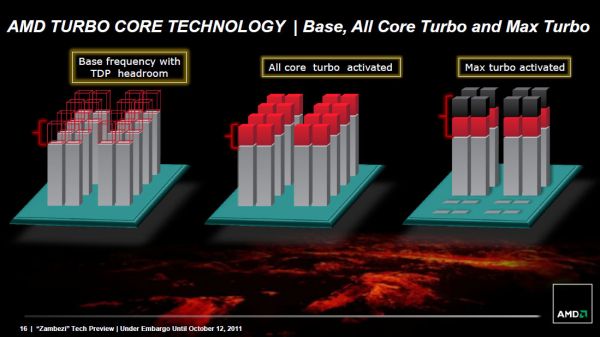








430 Comments
View All Comments
Iketh - Thursday, October 13, 2011 - link
I play FSX and Starcraft 2... both require copious processing power.And I just built an i7-2600K system with a radeon 6870 and blu ray writer for.... $960
paultaylor - Thursday, October 13, 2011 - link
While the benchmarks are very revealing of the "ahead of its time" nature of Bulldozer, I think AMD should've kicked off by focusing on server applications instead of desktop ones.Considering what I've seen so far I think some additional benchmarks on threading/scaling would come in handy – it would actually show the true nature of BD as, right now, it’s behaving like a quad-core processor (due to the shared nature of its architecture, I presume) in most cases, rather than an octacore. Charting that out might be very revealing. The situation now looks like Intel's 2nd (3rd?) generation hyperthreading quad-cores provide more efficient multithreading than 8 physical cores on an AMD FX.
Don’t get me wrong, we’ve heard from the beginning that BD will be optimised for server roles, but then we’re outside the feedback loop. Shouldn’t someone inside AMD be minding the store and making sure the lower shelves are also stocked with something we want?
A longer pipeline and the old “we’ll make it up in MHz” line reeks of Netburst, unfortunately, and we all know how that ended. Looking at the tranny count, it’s got almost twice as many as the Gulftown, with 27% bigger die size for the entire CPU… which will mean poorer yields and higher costs for AMD, not to mention that either the fabbing process is really being tweaked or the speed bumps will not come at all, as the TDP is already high-ish. Ironically it reminds me of Fermi. Speaking of which… BD may become the punchline of many jokes like “What do you get when you cross a Pentium 4 and a Fermi?”
On the other hand it seems AMD has managed one small miracle, their roadmaps will become more predictable (a good thing from a business perspective) and that will exert a positive influence with system integrators. Planning products ahead of the game, in particular in this 12-month cycle, might do some good for AMD, if they survive the overal skepticism that BD is currently "enjoying".
Other than that, another fine unbiased article.
rickcain2320 - Thursday, October 13, 2011 - link
Bulldozer/Zambezi seems to look more like a server CPU repackaged as a consumer grade one. Excellent in heavily threaded apps, not so hot in single threads.One CPU that is promised but isn't here is the FX-4170. I would have liked to see some benchmarks on it.
gvaley - Thursday, October 13, 2011 - link
We all get that. The problem is, with this power consumption, it can't make it into the server space either.kevith - Thursday, October 13, 2011 - link
Having waited so long for this, it´s a bit disappointing, when I compare price/performance.I went from C2D E 7300 acouple of years ago, and changed setup to Athlon II x2 250, and the performance difference made me regret right away.
And now, I have to change my MB and memory to DDR3 no matter what I choose, Intel or AMD. So I´ve looked forward to this release.
And it makes my choice very easy: I´l go back to Intel, no more AMD for me on the CPU side. And Ivy Bridge is coming, and will definetely smoke AMD.
Which is sad, it would have been nice with some competition.
eccl1213 - Thursday, October 13, 2011 - link
Earlier this week most sites reported that the FX and BD based Opteron 4200 and 6200 where both being released on Oct 12th.But I haven't found a single review site with interlagos benchmarks.
Have those parts been further delayed? We know revenue shipment happened a while back but I'm not seeing any mention of them in the wild yet.
xtreme762 - Thursday, October 13, 2011 - link
I haven't bought an Intel chip since 1997. But with this BS bulldozer launch, that is now going to change! amd should be ashamed of themselves. I for one will now sell all of my amd stock and purchase Intel. I will probably only end up with a few shares, but at this point, I cannot see supporting liars and fakes. And I will NEVER buy an amd product again, not a video card, cpu, mobo, not nothing! What a disappointment amd is.....All the amd crap I have will be tossed in the trash. I'm not even going to bother trying to sell it. WooHoo amd made a world record OC with a cpu not worth it's weight in dog poo!
connor4312 - Thursday, October 13, 2011 - link
Very interesting review. I'd be interested to see Bulldozer's benchmarks when it's overclocked, which, if I am correct, is higher than any Intel CPU can go. AMD seems to have made a turnaround in this aspect - Intel CPUs were historically more overclock-able.Suntan - Thursday, October 13, 2011 - link
As always, a very detailed review. But what about the capability of the "value" chips? Namely, is it worth it to spend around $100 to replace an Anthlon X4 with an FX4100?There are a number of us that picked up the X4 a couple years back for its low cost ability to encode and do general NLE editing of video. Is it worthwhile to replace that chip with the FX4100 in our AM3+ mobos? And what kind of improvements will there be?
As you rightly stated, a lot of us are attracted to AMD for their bang-for-buck. Just because the industry as a whole wants to bump up prices endlessly, there are still a lot of us that like to see good comparisons of the performance of CPUs available for around 1 Benjamin.
-Suntan
Pipperox - Thursday, October 13, 2011 - link
Frankly, it seems to me the disappointment of AMD fans to be quite excessive.Worst CPU ever?
What was then Barcelona, which couldn't compete with Core 2?
Bulldozer, set aside old single threaded applications, is slotting between a Core i5 2500 and Core i7 2600K.
Which other AMD CPU outperforms in any single benchmark a Core i7 2600k?
A higher clocked Thuban with 2 extra cores would have been hotter and more expensive to produce.
Setting aside AMD's stupid marketing, the AMD FX-8150 is a very efficient QUAD core.
The performance per core is almost as good as Sandy Bridge, in properly threaded applications.
Then they came with the marketing stunt of calling it a 8 core.. it's not, in fact it doesn't have 8 COMPLETE cores; in terms of processing units, an 8 core Bulldozer is very close to a Sandy Bridge QUAD core.
The only reason why Bulldozer's die is so large is the enormous amount of cache, which i'm sure makes sense only in the server environment, while the low latency / high bandwidth cache of Sandy Bridge is much more efficient for common applications.
I think with Bulldozer AMD has put a good foundation for the future: today, on the desktop, there is no reason not to buy a Sandy Bridge (however i'm expecting Bulldozer's street price to drop pretty quickly).
However IF AMD is able to execute the next releases at the planned pace (+10-15% IPC in 2012 and going forward every year) THEN they'll be back in the game.